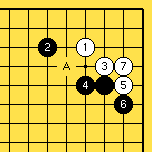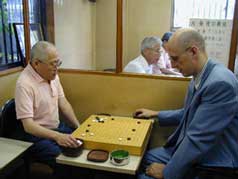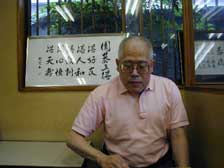
Introduction
Pieter, 31, has studied go at the local branch of the Nihon Ki-in in central Japan. He lives with his family in Kasugai City, near Nagoya. He is a steady contributor of articles about the Japanese go scene for the Dutch Go Association. He has recently interviewed Tsuchida Masamitsu 9-dan.
Kitani Minoru - a class apart
Kitani Minoru (1909-1975) can, with confidence, be described as one of the only players who could hold his own over a long period against Go Seigen. At the same time he was a driving force behind the development of go in the 20th century in Japan and Korea. Characterised by an unrelenting enthusiasm combined with a pure genius, he was for the go world an enduring source of inspiration and stimulation.
The achievements of Kitani on behalf of the go world are especially significant, but he will always be remembered for three things in particular by people familiar with go. First he is famous for Shin Fuseki. This new fuseki is often mentioned in the same breath as Go Seigen, but it was perhaps more the brainchild of the theoretician Kitani than of Go Seigen. Next, there was a large number of josekis developed by Kitani and, although many are no longer so popular, each day on go boards all over the world corner patterns still appear that bear the stamp of Kitani.
When I buttonholed a pro and asked him for a good example of a Kitani joseki, the answer was the 5-3 joseki in Diagram 1.

Diagram 1
This is a sequence which is still played and was typical of Kitani. It is usual to move out with A instead of 3. The diagonal blocking play of Kitani appears at first sight to be the move of a 5-kyu or worse. White banks real territory and settles the situation. After white 6 black often plays elsewhere.
The direct clash in 1933 between Go Seigen and Honinbo Shusai Meijin is for a number of reasons often labelled "Game of the Century." This game, which Shusai managed to win, was seen as the first direct confrontation between old and new ways of playing and enjoyed enormous publicity. The game Kitani-Shusai (1938), played in honour of Shusai's decision to round off his career, can be seen as a second direct encounter between old and new. This game was, if anything, given an even higher profile.
The press was over the moon, because the newspapers now had, after five years, another "game of the century" to attract their readers. The players had 40 hours thinking time each, but halfway through the game the stress became too much for the 64-year-old Shusai and he had to take three months rest on his doctor's advice. The game was finally concluded on 4 December and the 29-year-old Kitani won by five points.
Nobel prize winner Kawabata Yasunari wrote about this especially dramatic event in his book "Meijin", which has since become famous and had been translated as the "Master of Go". The name of Kitani in this book has been altered to Otake. This choice of name has nothing to do with the top pro Otake Hideo, who was then not even born.

Figure 1: 1-100
Immediately after Kitani had read "Meijin", he said: "I cannot say that I am entirely happy. The mere thought that everything that Otake says and does in the book will be interpreted as things that I myself have actually said and done is unbearable. The book "Meijin" is in reality not a documentary about the main protagonists in a game, but a novel in which Kawabata has used my person as a model for Otake. Otake and I are certainly not the same person."
Incidentally, under pressure from Kitani, this game was played with sealed moves after each playing session. This was a new experience for Shusai which he was, however, loath to talk about. When Kitani, halfway through the game, played a kikashi as his sealed move (Black 121 in Figure 2), the atmosphere became uncomfortable and Shusai made no secret of his ire.
The third, and for the go world the most important, reason for Kitani's fame is the number of pupils that he has trained in his own dojo. In summary, at the end of the fifties Kitani was one of the five top players in Japan, and from the sixties onwards it was his pupils who took over the torch from him. Among Kitani's best known followers we can mention Cho Chikun, Kobayashi Koichi, Kato Masao, Takemiya Masaki, Otake Hideo and Ishida Yoshio. Without exception these top pros were good for one or more titles, and they still stand at the top, 25 years after the demise of the master.
Cho Chikun is merely one of Korean geniuses from the Kitani stable. In total six pupils from Korea managed to find their way to his dojo. Among them was also the man who set up the Korean Go Association, Cho Nam-ch'eol, an uncle of Cho Chikun. (Another top Korean pro, Cho Hun-hyeon, the mentor of the present number one in the world Yi Ch'ang-ho, was not a student of Kitani but of Go Seigen's teacher, Segoe Kensaku.)
Tsuchida Masamitsu, 9-dan - Kitani Pupil

Tsuchida Masamitsu 9-dan and Pieter Mioch
In Nagoya, there are also two professionals from the Kitani stable. After a quick phone call I was able to hear from Tsuchida Masamitsu 9-dan how he came to the Kitani dojo and to ask exactly how one dojo could bring forth so many top players. Tsuchida, who is well known for his suspicious expression, thawed perceptibly when we sat down over tea and he began to talk about his master Kitani. "On my twelfth birthday I was accepted by the Kitani Dojo. As I recall, there were three rooms of about 15 square metres, which were made use of by 10-20 persons. The majority of the aspiring professionals were between 5 and 15 years old. The 5-year-old nipper was Cho Chikun. We slept there on our mattress, which in the morning were folded up in the cupboard to make room for the go boards."
He described the daily roster as follows:
| 06:00 | Rise |
| 06:00-07:00 | Play through professional games |
| 07:00 | Morning calisthenics (from the radio) |
| 07:30 | Breakfast |
| 08:00 | School |
| 15:00-17:00 | Return from school, in-between snacks; then sport: softball |
| 17:00-18:00 | Evening meal, clearing away and doing the dishes |
| 18:00-21:00 | Playing and discussing games |
| 22:00 | To bed |
"You surely played each day with Master Kitani?"

Tsuchida Masamitsu 9-dan
"Certainly not. Kitani was for us a sort of god, and the honour of playing with him was almost unimaginable. Only the best pupils could play with him. That is to say, one game upon admission to the dojo and one game at the time you were promoted to professional. As far as I know, only Otake Hideo was able to play both games. It is not unusual that the pupil never plays with the master at all, at least in my experience."
Although Tsuchida says this extremely laconically, his expression betrays how sad he finds it never to have played with Kitani. At the same time, it seems he is resigned to accepting that this is the usual way of things.
"Was the dojo a commercial enterprise?"
"No. It was never the case that Kitani had a steady source of income through keeping us in his house. On the contrary, I should say. It was actually the time of the second world war, after which there was, to be sure, enormous poverty and sometimes even hunger throughout Japan. Kitani himself had seven children. In that case, although this is purely my own opinion, it is I think easier to have 27 children instead of seven because a great deal can be sorted out in the housekeeping."
"Kitani never spoke a word when his pupils set to work behind their boards, half smiling as he looked at each game attentively and wandered back and forth behind us. Kitani was completely engrossed by the game of go. One joke amongst us was that there were in the whole of Japan only three men who never had their own purses with them. One was the Emperor, who was so far above the condition of ordinary men that he naturally never had any truck with such coarse things as money, and the other two were Go Seigen and Kitani, who were both so removed from the world and thought about nothing but go that they never realised that money was sometimes necessary."
"When Kitani had to go somewhere, Mrs Kitani (Kitani Miharu) always sent one or more of us with him to carry his purse and to ensure that nothing untoward happened. For example, Master Kitani sometimes had not even noticed that the sash that everyone wore around the middle of his body had come loose as he was walking along. Post haste the pupils had to then ensure that master did not wander along the street half naked before someone spotted him!"
"Did Go Seigen also come and play a quick game?"
"Most definitely not. Although Kitani and Go could play each other on level terms, they never did so. The only way in which we or master Kitani could play with Go Seigen was by performing well in the professional tournaments, so that we were drawn against him. There was also great rivalry among the pupils themselves. Mrs Kitani, who was the real head of the Kitani dojo, since besides the go games the whole load rested on her shoulders, was relentless towards badly performing pupils. They had to go back home and were not allowed back in."
"Good performances were therefore the most important thing?"
"That is to put matters in a rather black-and-white way. Playing well and winning is naturally important, but you must understand that at the time there were actually only two kinds of schools. On the one hand, you had players with Segoe Kensaku as their mentor. Master Segoe thought that the game of go was about to spread once again throughout Asia like a raging fire, and that it was the business above all of aspiring professionals to become strong quickly in order to resist the onrushing competition. For him, talent was important above all. Hashimoto Utaro, Go Seigen and the top Korean player Cho Hun-hyeon were the entirety of the school. The representative of the second kind of school was Suzuki Tamejiro. For Suzuki the most important thing was the ability to "give one's all", literally everything, in favour of go. Kitani was the star pupil of this Suzuki and he played according to the very same ideas, placing continuous studying and improvement above results."
"Master Suzuki was of the opinion that the ideal go player had to devote himself completely to each aspect of his daily life that had even remotely anything to do with go, mentally or physically. Suzuki demanded of pupils not so much that they had to become strong quickly, but that they gave themselves up to go, as if they were monks in a go monastery. With this setup Suzuki was true to traditional Japanese philosophy, and he can perhaps best be compared with the medieval guildmasters in Europe who also demanded from their apprentices absolute devotion to their trade. Segoe placed quick results above tradition, a way of thinking that is characterised by the way in which the Japanese company has altered during the 20th century."
"What then was the precise reason that Kitani's pupils became so strong?"
"It helps, of course, that Kitani trained a total of 70 pupils. Plenty of them have never won a title, you know. But, setting that aside, I think that the system of uchi-deshi [the system in which the pupil was adopted by the school] is so intense that the mental strength and the toughness to remain upright and be able to endure and withstand everything are honed to the utmost. All Japanese title winners, so far as I know, have begun as uchi-deshi."
"Another possible reason for the success of the Kitani school is Kitani's personality. He had an aversion to telling a person what he had to do, reasoning that the best way of completely understanding something was to discover first for oneself. He thought that the most important thing was to keep the identity of his pupils intact on the board and if possible to stimulate them further. That can easily be understood when you consider that Cho, Kobayashi and Takemiya all played with three totally different styles even though they were all members of the Kitani dojo at the same time. A player for whom Kitani had great respect, and who himself clearly made perfection subordinate to winning, was Kajiwara. When Kitani was taken into hospital the first time, it was Kajiwara who took the place of the Master."
"As regards the present day, I think there is little chance that there will ever be a dojo set up that can match Kitani's dojo. In the Japan of today, it is difficult to find a wife like the one Kitani married. Mrs Kitani Miharu actually did not play go, but she treated each pupil in the Kitani dojo as her own flesh and blood. She made herself responsible for all the pupils, lock, stock and barrel. In fact, Mrs Kitani made the greatest contribution to creating an ideal atmosphere in which young talent had the chance to develop in full."
This article appeared in "go" the bimonthly magazine of the Dutch Go Association, in issue 37-3, June 2000. The first version English version appeared on the web on 14 August 2000 on the Mind Sports Online Go pages as a special.
Translated from the original Dutch, with permission, by John Fairbairn.
Pieter Mioch can be contacted at pmioch@ma.ccnw.ne.jp
